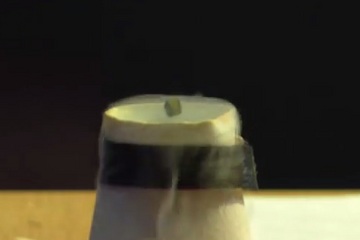| Online: | |
| Visits: | |
| Stories: |
How’d He Do That? Physicist Demos Quantum Levitation (Video)
Saturday, October 4, 2014 8:06
% of readers think this story is Fact. Add your two cents.
(N.Morgan) Levitation has been a point of fascination for thousands of years. To possess such a power, as in to float where one wished anywhere at any time. To be able to travel from Point A to Point B, in the blink of an eye. In a incredible discovery Harvard physicist Subir Sachdev doesn’t need magic to levitate objects. He now is the possessor of the secret to levitation. Sachdev performed a levitation demonstration using a magnet and a superconductor during a presentation at the Perimeter Institute on Oct. 1. Superconductors are incredible materials that can conduct electricity with zero resistance.
with zero resistance.
But to generate the superconductivity, the material has to be extremely cold, and so Sachdev poured liquid nitrogen that’s about minus 320 degrees Fahrenheit (minus 195 degrees Celsius) on the superconductor to trigger its superconductive state. “One of the key properties of superconductors is that it hates magnetic fields,” Sachdev said during his levitation demonstration. And so as the superconductor “repels” the magnet, the magnetic cube is lifted into the air. The magnet will fall after the superconductor begins to warm up again. But superconductors aren’t just for levitation demonstrations, Sachdev said. [The Cool Physics of 7 Classic Toys] “The hope is that these materials will actually be useful for something,” Sachdev said.
Quantum mechanics 101
Physicists are still not entirely sure what gives a superconductor its magiclike properties and why superconductivity doesn’t work above a certain temperature, but Sachdev said he thinks he’s pretty close to the answer. But to understand how a superconductor works, “you need to know some quantum mechanics basics,” Sachdev said after his levitation demonstration. The main idea of quantum mechanics is that an object like an electron or a photon behaves as both a particle and a wave, Sachdev said. “That’s one of the key mysterious properties of quantum mechanics,” Sachdev said. The other weird characteristic of quantum particles is that they can exist in multiple places at once, a phenomenon called superposition. But superposition is a fragile state. The moment that scientists try to measure the particles, the superposition state collapses and the particles come to exist in only one spot. Before the particles are disturbed, they exist in multiple places all at once, and “yeah, you just have to accept it,” Sachdev joked during his presentation.

The magnetic cube hovers in the air as liquid nitrogen flows around the superconductor beneath the cube.
flows around the superconductor beneath the cube.
More Stories Contributed By N. Morgan






Please DO NOT HATE ME FOR NOT KNOW THIS….but…(lol) Do you have a YouTube channel? Web-site? I’ve always enjoyed your contributions here on BIN….your a Dimond in a sea of crap on here…LoL
Thanks for your time…
Concerning the article…it seems like I’ve read somewhere that getting the “Material” for magnets…is hard…especially the larger you need it.
tracehdridefree, thanks for your kind words!
You can just type in N Morgan into Youtube and my page will appear.